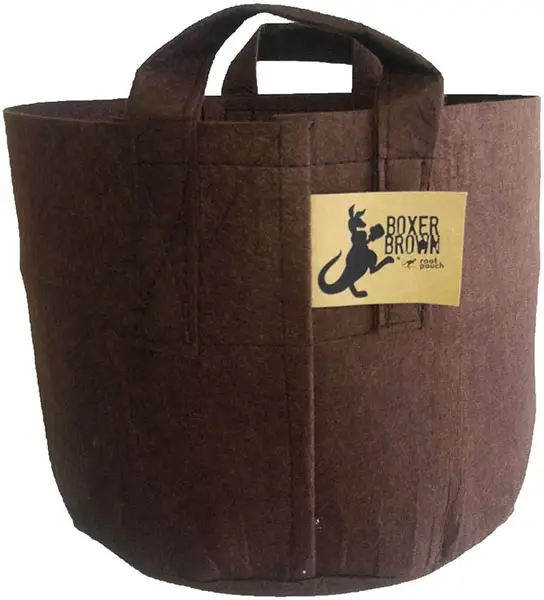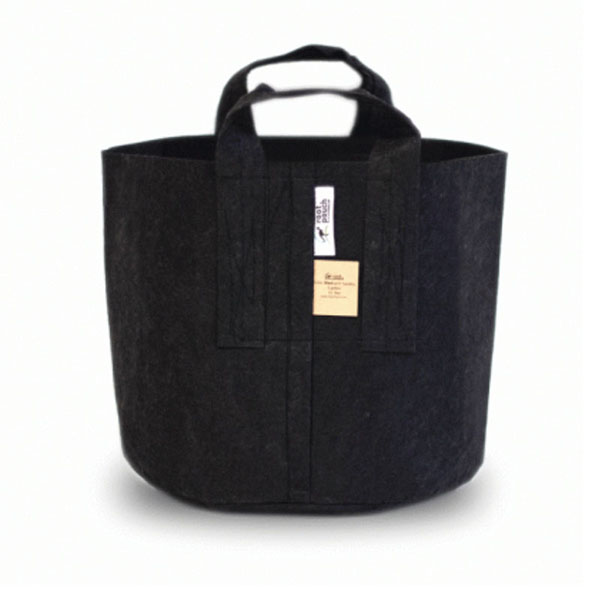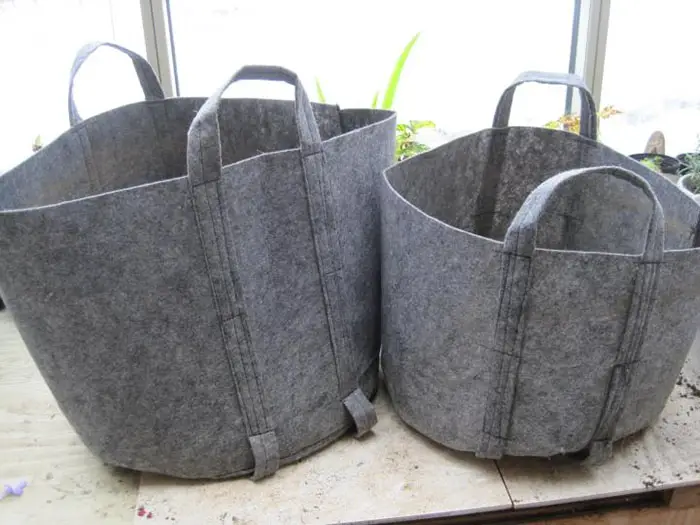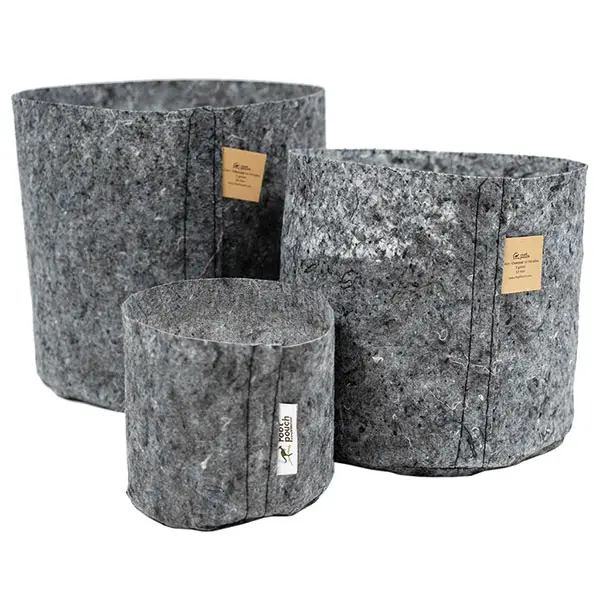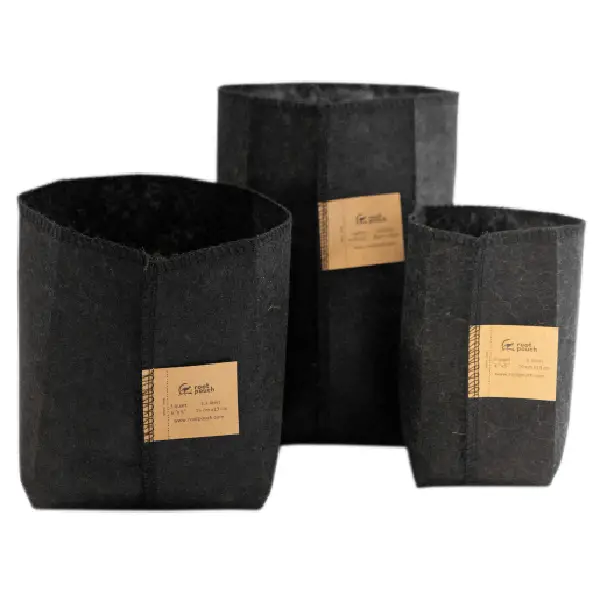Many advantages exist when using a fabric container as opposed to the standard plastic one. It’s a common misconception that any fabric grow bag will suffice for the purpose of nurturing plants. There is clearly a distinction between them, so this cannot be correct.
Root Pouch, like other, grow bags, can provide you with useful extras. The plastic used to create Root Pouch grow bags comes from used water bottles. They don’t break easily, are safe to use in the sun, and won’t let any harmful chemicals seep out. The PET they use is a blend that includes natural fiber (polyethylene terephthalate). Such a heterogeneous composition gives the bag the magnetic pull necessary to attract liquid. This means the plant can supplement drip irrigation with other methods.
Root Puch is well-known for making reliably grow bags, and for good reason. Using cutting-edge manufacturing techniques, they have developed a third-generation grow bag that combines synthetic and natural fibers.
When it comes to fabric storage containers, Root Pouch is the only company in the world that actually makes its own fabric. This ensures that the company has complete say over all inputs, including raw materials. To meet the needs of their customers, they can make fabric containers of various sizes and shapes.
This bag stands out among others because it is the only grow bag authorized by the Food and Drug Administration for use in food production. That way, we can be sure it’s completely safe for use in food production.
Benefits Of Using Root Pouch Grow Bags
The popularity of root pouch grow bags among gardeners and cultivators alike are on the rise. In addition to being a convenient way to kick off a gardening project, their many other advantages make them the superior option for any planting endeavor.
Using a root pouch couldn’t be simpler. The bags are easy to transport thanks to their lightweight construction, and the design promotes healthy plant growth by allowing the soil to breathe. In addition, these grow bags can be reused without fear of degradation from chemical exposure or weathering because the fabric is used rather than plastic or other materials. Long-term, this is beneficial because of the money saved and the reduced environmental impact.
Using root pouch grow bags can reduce water waste by as much as 70 percent. This is because less water is lost to evaporation thanks to their design, making them ideal for hydroponic gardening. Also, the bag’s high drainage capability lessens the likelihood of root rot due to overwatering.
Size And Capacity Considerations
There is a wide range of root pouch grow bags available, each with its own specific size and capacity. Please take into account the following three factors:
- The pot should be large enough to accommodate the plant’s mature root system while still allowing for adequate ventilation and drainage.
- Think about how much compost or soil you’ll need to fill the bag to its top, as having too much or too little can stunt your plants’ growth and impede airflow.
- The grow bag’s depth should be adjusted as needed to accommodate the specific plant’s root system.
You should also consider the grow bag’s shape and construction to find out if it can be used more than once. There’s no reason to settle for a less-than-ideal root pouch grow bag now that so many excellent options are available.
3 to 4 Year Bag
The company does release a grow bag known as a 3 to 4 years bag. That means that it’ll start the biodegradable parts of this bag in 3 to 4 years. It then allows the roots to squeeze and break through because they start to biodegrade.
When the little root tips get to the fabric, they can’t get through, and they can’t squeeze, they just get trapped there, so they send another root. With this, you will get a beautiful root structure.
They harvest trees in three to four years and take them down to the ground. After they’ve already formed a perfect dense fibrous root structure, then when the third year hits, they start breaking down.
Because they come in various sizes, shapes, and colors there will always be something that fits perfectly into whatever space you need it in. The material itself is breathable too meaning your plants won’t suffer from over-watering or heat stress like with plastic pots.
Types of Bag Available
There are 5 main types of Root Pouch grow bags available. They are categorized in different colors.
Boxer Line
You can get Boxer Fabric in different sizes ranging from 1 gallon up to 600 gallons. You can get either with or without handles.
Root Pouch’s Boxer Line of grow bags is a must-have for anyone looking to maximize their garden potential. Made from recycled plastic bottles, these lightweight and durable containers are designed with convenience in mind.
The material used gives an added benefit by providing insulation against extreme temperatures and UV rays. This allows you to plant earlier in the season and increase your chance of successful harvests!
The unique design also includes multiple drainage holes around the bottom, allowing excess water to escape while still retaining essential moisture levels. Additionally, they feature strong reinforced handles so you can easily move them when needed – like at harvest time. They’re incredibly affordable compared to other types of planters on the market today.
Black Thickest Fabric
If you want to get the most durable semi-degradable root pouch, then this black line fabric bag is the one you should go for. Like Boxer Line, the size of this bag ranges from 1 gallon up to 600 gallons. It is also available with or without handles.
Root pouch grow bags made with the black thickest fabric are known for their durability. These bags are designed to last a long time, as they can withstand exposure to UV rays and extreme temperatures. These root pouches have great drainage capabilities, which allows them to absorb excess water while keeping your plants healthy. Additionally, the material is breathable – allowing air circulation inside the bag to ensure optimal growth of your plant’s roots. The fabric also helps retain moisture in order to keep soil from drying out too quickly.
The black thickest fabric is an ideal choice for those who want their root pouch grow bags to look good for extended periods of time without having to replace them often. This type of material won’t fade or lose its shape even after being exposed to direct sunlight for long hours every day.
It’s also resistant to mold and mildew so you don’t need to worry about your root pouch becoming infested by pests or diseases. Finally, this tough material makes it easy for you to move and handle your root pouch since it’s lightweight yet strong enough not to tear easily when handled roughly.
These features make the black thickest fabric an excellent option if you’re looking for a durable and reliable way to hold your plants’ roots securely while providing aeration and water retention at the same time. Not only will this help keep your plants growing healthily, but it’ll also give your garden a stylish touch.
Grey Thick Fabric
This is the most versatile semi-degradable Root Pouch you can get. It featured a 250 g/m2 natural fiber blend, and it is a semi-degradable root pouch. The size of this bag ranges from 1 gallon up to 25 gallons. You can get it with or without handles. This bag is built with higher content of natural fiber in it. It is ideal to be used for in-ground growing.
It is based on geotextiles, which are fabrics used in civil engineering projects to prevent soil erosion or weed growth. This material allows oxygen to reach the roots while providing protection from disease, pests, and heavy rains.
The grey color also prevents light penetration into the bag so it can help regulate temperature on those hot summer days when plants need extra protection.
The thickness of the fabric is beneficial because it can withstand wear and tear better than thin materials, making root pouches an ideal choice for a gardening year after year. Its structure is strong enough to support large plantings without tearing or splitting under pressure. Plus, if you choose to use containers within your root pouch setup, they won’t move around as easily due to their rigid nature.
When caring for your plants using these grow bags, be sure to water them regularly as this will ensure healthy growth throughout their lifetime. Controlling moisture levels is key; too much or too little could have serious effects on your plants’ health so always check the instructions provided by the manufacturer before getting started.
Charcoal Thin Fabric
This Charcoal Thin Fabric is a 150 g/m2 natural fiber blend and Semi-degradable bag. The size of this bag ranges from 1 gallon up to 7 gallons. It is ideal to be used in grow rooms or for indoor growing. The bag is skinny and very lightweight. It can help in root control and root pruning.
Thee second layer of root pouch grows bags is a lightweight, breathable material that ensures proper aeration for roots. It aids in temperature regulation and water flow while protecting seedlings from pests and diseases. This charcoal cloth provides protection against UV radiation and maximizes oxygen transfer to plant roots.
Its fine mesh structure makes it ideal for use as a filter when mixing soil composts or fertilizers into your planting mix. The lightweight design also helps reduce shipping costs associated with large orders.
This type of fabric is highly resistant to fungal growth which means you don’t have to worry about disease problems caused by moisture buildup inside the bag. Additionally, this charcoal woven material allows the user to easily inspect their plants without having to remove them from the growing container.
Its durability means that these bags can be reused multiple times over years without any noticeable wear or tear – making them an economical choice for gardeners who are looking for long-term solutions.
Black Thin Fabric
This is the thinnest fabric bag manufactured by Root Pouch. It is a 90 g/m2 natural fiber blend and semi-degradable for 12-15 months.
Most people are using this bag for propagation purposes. The bag forms a square bottom. When turned inside out, it forms a round bottom like traditional pots. The available size for the Black Thin Fabric bag is from 1 pint to 3 pints. There are no handles for this bag since it is just a small bag.
The special material used to create root pouch grows bags is a thin, black material that is both strong and effective. A few of the many uses for this material are:
- The fabric’s porous structure enhances root development and nutrient absorption, leading to healthier plants.
- It’s simple to use; the pliable material allows it to squeeze into small spaces, so you won’t have to move around heavy bags of soil or other bulky items.
- It’s lightweight but durable: even when loaded with dirt and water, this fabric won’t rip easily.
Because of these features, it is an excellent option for home gardeners or professional growers in search of more efficient alternatives to ordinary flower pots and planters. Moreover, your investment will be safe and sustainable because the fabric is non-toxic and recyclable. All of these benefits make it clear why root pouches have caught on with city gardeners and avid plant caretakers.
Composting With Root Pouch Grow Bags
There’s a proverb that goes something like, “What one man throws away, another man will find priceless.” This is best illustrated by the use of root pouch grow bags. If you use them for composting, these bags can last for years after you’ve used them to store soil and plants for a season or two. You can give your root pouch grow bag a second life and reduce the amount of waste sent to landfills by composting it.
The inside of a root pouch grow bag must be cleared of any remaining plant matter prior to composting. This will aid in the decomposition process and discourage pests from lingering. Once you have removed all organic material, rinse the bag with water and allow it to dry completely before moving on to the next stage of composting.
Then you can combine equal amounts of carbon-rich materials and nitrogen-rich materials (like grass clippings) (like shredded leaves). Put this material in the bottom of your root pouch grow bag in an even layer, and then cover it with several inches of course mulch or wood chips.
Add nutrient-rich potting soil, such as manure or fish emulsion fertilizer, to the remaining space in your root pouch grow bag. Water thoroughly, and let nature take its course; in a few weeks, you should see signs that your root pouch grow bag is decomposing into rich hummus that can be used in gardens or given as gifts to gardeners.
Reusing Root Pouch Grow Bags
Root pouch grow bags are incredibly versatile and can be reused for several growing cycles. You don’t need to replace the entire bag or throw it away once you’re done with a growing season, as these bags are designed to endure wear and tear for multiple uses. To get the most out of your root pouch grow bag, there are certain practices that should be observed in order to promote long-term usage.
One key practice is thorough cleaning at the end of each use; this will help ensure that any lingering bacteria from previous plants don’t contaminate new ones. Using a garden hose or pressure washer can help remove dirt and debris from the surface while wiping down the interior with an all-natural cleaner can effectively sanitize it before using it again. Additionally, after two or three seasons, consider replacing any worn parts such as straps or handles. Doing so will prevent them from breaking during future uses.
Finally, when storing containers between growing sessions make sure they’re completely dry before closing them up for storage. Moisture trapped inside could cause mold growth which would permanently damage the fabric and reduce its lifespan significantly —making proper drying essential. With regular care and maintenance, root pouch grow bags can last you many years—allowing you to enjoy their convenience season after season!
Making Use of Root Pouch Grow Bags
When using Root Puch grow bags, the ones that do by air pruning will get a lovely little root, and it works great if it’s above ground. But when you want them to go in the ground, you don’t want a root to go through looking for air because there’s no air in the ground.
Just like if you were doing a potting pot. You don’t want a grow bag or fabric working on air pruning because there’s no air in there.
The Root Pouch does not only have the natural fiber mixed in, but its texture won’t allow the roots to squeeze through. They’re just trapped.
The bag is injected with natural fiber, and it will absorb the water that is being used in the ground, and at the same time, it also helps to bring water into the container for the consumption of the plants.
Natural fiber can act as insulation for the roots of plants. It can help to keep them cool during summer and keep them warm during winter.
What Happens When You Take The Root Patch Out Of The Ground?
Removing a root pouch grow bag from the ground can be one of the most important steps in the growing process. The roots must be carefully extracted, ensuring that all the nutrients and moisture embedded within the fabric are maintained. To do this, it is best to use gloves when handling the root patch and you may want to cut open or tear apart any sections which appear too dense for removal.
When removed, check for signs of disease or pests that could have been affecting your crop while inside its pouch home. After inspection, gently wash off any soil particles with cool water before hanging them up to dry completely. If left wet and unattended, bacteria and mildew growth can occur quickly on both sides of the fabric material.
Once thoroughly dried, inspect it again for any potential issues or problems before storing away until ready for planting again. Storing correctly will help ensure the longevity of these remarkable containers as they offer an effective solution to reach successful harvests season after season.
With proper care and maintenance, there’s no limit to how many times and plants you can reuse your root pouches! From vegetables such as tomatoes, carrots, and zucchini to flowers like roses and daisies; whatever you choose to plant, these bags provide consistent nourishment throughout their lifespan – making them incredibly reliable garden companions!
Innovative Uses For Root Pouch Grow Bags
Root pouch grow bags are the ultimate tool for gardeners, offering an environmentally friendly alternative to traditional containers. Their innovative design is perfect for a variety of uses, from small herb gardens and indoor houseplants to large outdoor vegetable patches. Here are some creative ways to use root pouch grow bags:
First, you can use them as portable planters – simply fill with soil, attach handles or straps, and transport them! This makes it easy to move your plants around without disturbing their roots as much as when using other potting methods. Root pouches also make excellent vertical gardening systems, allowing you to create beautiful displays of foliage along walls or fences. They even come in attractive designs that will add a unique touch to any space.
Another great thing about root pouch grow bags is that they provide superior drainage compared to many other container types. The fabric material allows air and water through while still providing enough support for the plant’s roots – ideal if you’re looking to save on watering costs and prevent over-watering. Plus, depending on the size of the bag, several seedlings can be planted at once so there’s no need to worry about overcrowding either!
Storage Guidelines For Unused Root Pouch Grow Bags
It is important to store unused Root Pouch grow bags in an environment that will preserve the integrity of the material and allow for long-term use. Here are some key tips on how to properly store your Root Pouch Grow Bags:
- Store them in a cool, dry area out of direct sunlight. This will help prevent UV radiation from weakening the fabric over time.
- Keep them away from excessive moisture and humidity as too much moisture can cause mold or mildew buildup on the fabric.
- Make sure to hang up any excess weight such as soil or water so that it does not weigh down the bag when stored.
When storing Root Pouch Grow Bags, you should also consider using airtight containers with desiccant packets inside in order to further protect against moisture damage. If you plan on storing your Grow Bags for extended periods of time, make sure to check on them periodically to ensure they remain in good condition. Taking these few simple steps will ensure your Root Pouches stay strong and ready for use whenever you need them!
Final Thought
Many growers face problems where they are struggling to transfer the plants from the bag to the ground. After all, the roots were growing through this whole cycle because the plant roots are trying to air prune.
But for this Root Pouch grow bag, the roots are just left rock solid. They are not breaking through until you want them to. After the third or fourth year, you can rip it off quite easily, and when it does, it takes off all the little root tips with it. So it’s like prunes it, and right behind it is that nodule of carbohydrates, and it just explodes into the new environment.
For other grow bags, a lot of times when the things are not to fault other bags, but when you rip off the bag, the nodule and everything is coming on with it because it’s caught inside the bag.
Once you have finished using the grow bag, you can fold it down flat and keep it for storage. If you found the bag is dirty, you can throw it into the washing machine to wash it clean. Then pack it away until you start up your spring garden again.
I like to use them because they allow air to go into the roots, as they need a little bit of air. The roots will grow to the fabric. The warm, dry air on the outside will kill those roots off. New younger roots that are more efficient at taking up nutrients and water will then start growing from the base of the plant.
I have set it up using a 95-liter or 25-gallon root pouch. Generally, I use them to grow citrus, tangerine, lime, or lemon from small containers.
If you want a good grow bag for propagating your plants, why not give it a shot? You’ll get up and be far happier with the result you will get with this grow bag.

